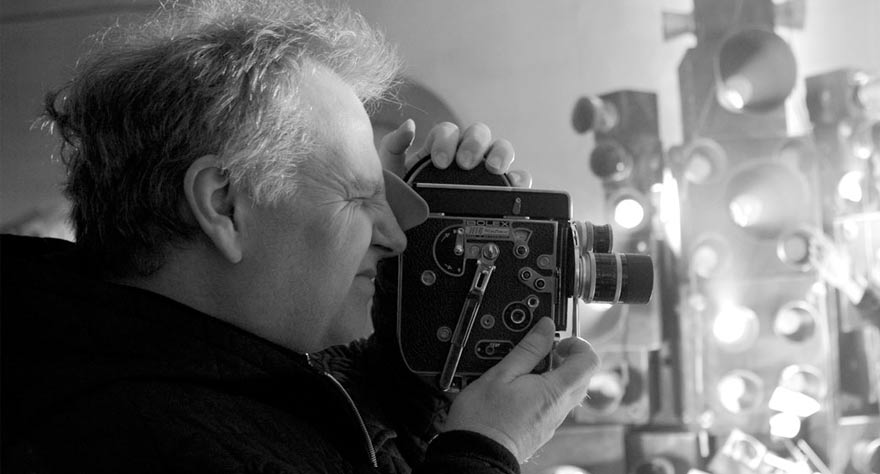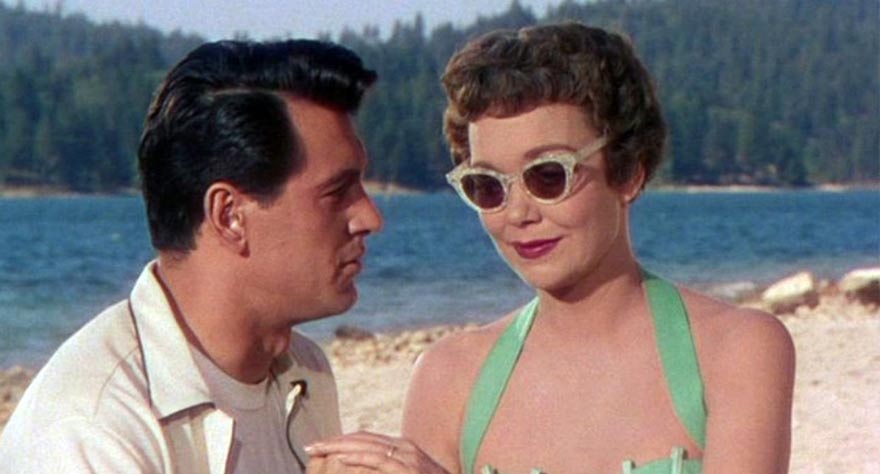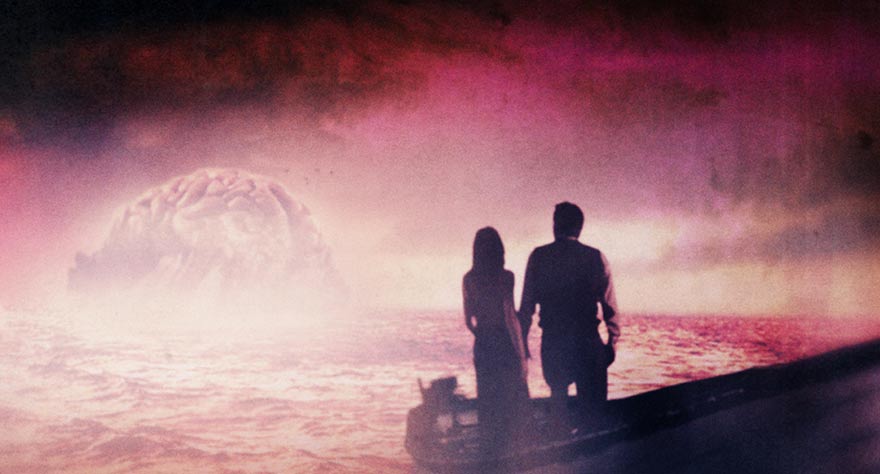Guy Maddin on Sirk, Technicolor, and Film’s “Super-Democratization”

From the looks of it, Guy Maddin’s been having a good year. Back in January, his 2007 “docu-fantasia” My Winnipeg received a DVD and Blu-Ray release on The Criterion Collection. Around the same time, he premiered his latest work The Forbidden Room with co-director Evan Johnson at Sundance to rave reviews from critics. And most recently, when the Toronto International Film Festival revealed their 2015 poll of Canada’s top ten films of all-time, My Winnipeg came in at number nine on the list. Since he started directing in the ‘80s, Maddin has gradually become one of Canada’s most distinct, celebrated and all-around best filmmakers working today. Maddin, who describes himself as a dilettante, specializes in the early years of film, specifically the silent era and the transitional years when talkies began to take over. His films are both an homage to that time period and something entirely new. While most people may look back and see these production methods as antiquated, Maddin’s films feel like an exploration of the artistic possibilities of a largely abandoned mode of filmmaking.
This summer, TIFF has been presenting the “Dreaming in Technicolor” series to celebrate Technicolor’s centenary, screening over two dozen classic films, and Guy Maddin will host a Technicolor Master Class on Douglas Sirk’s 1954 melodrama Magnificent Obsession on July 18th. When asked about his own experiences watching Technicolor, Maddin quickly points out the importance of watching Technicolor on the big screen. “About ten years ago I saw The Wizard of Oz in a theatre,” he recalls. “I realized the experience…seeing something in Technicolor and on the big screen made a difference. I could actually see into the corners of the sets, stuff that was too tiny for me to see on a 25” living room television. You can see where the floor’s been polished, where the artifice got less intense, and a space for a production assistant whose job was to stand there with a mop in between takes so the munchkins’ footprints weren’t visible or something. You can sort of see there were limits to the seemingly infinite amount of art direction in Oz. I really liked that, it sort of gave the movie more breathing room. That’s more testimony to the transformative power of seeing Technicolor on the big screen as opposed to television.”
“My most recent experience was watching Black Narcissus at the Berlin Film Festival,” he says. “Seeing it on the big screen created a genre shift. I realized Black Narcissus is closer to being a comedy than a nun melodrama, that the very subtle differences in facial expressions were wildly recognizable. You could feel the horniness in this movie. The audience was laughing with the movie. It literally transformed the film from a drama to a comedy on the big screen. The big screen experience of Technicolor is what really excites me, and should excite visitors to Magnificent Obsession.”

Still from Magnificent Obsession
Part of why Maddin chose a Sirk film for his Master Class was for personal reasons. “Douglas Sirk is really important to me,” he explains. “When I first picked up a camera, I had the idea of ‘What should be the ultimate goal of a filmmaker?’ It occurred to me that the ideal film would be able to manipulate people into crying while laughing at the same time. This seemingly impossible, mutually exclusive display of emotions should be something to aim for as a filmmaker. I first experienced that really devastating double-pronged pair of emotions watching a Douglas Sirk film.”
That film was Written on the Wind, Sirk’s 1956 melodrama starring Rock Hudson, Robert Stack and Dorothy Malone. “I became so wrapped up in Robert Stack’s tragic story, so overwhelmed with how unloved he felt, and yet I was laughing at the movie because there was so much Technicolor delight and lurid, oversaturated plot lines. It’s one thing for the colours to be more saturated than they are in nature, but with melodrama the storylines, the very humans themselves are more saturated than life. I found myself laughing at the entire proceedings but being wiped out as well, sobbing and laughing at the same time.”
Magnificent Obsession follows rich playboy Bob Merrick (Rock Hudson), whose selfish and careless attitude almost kills him when he crashes a speedboat while taking it for a joyride. He’s saved thanks to a resuscitator owned by the town’s renowned physician Dr. Phillips across the lake, but in a tragic coincidence Dr. Phillips dies from a heart attack at the same time. Merrick realizes the town despises him for “killing” their beloved doctor, including Phillips’ widow Helen (Jane Wyman), whom Merrick falls for. In his attempt to earn Helen’s forgiveness and love, Merrick winds up causing an accident that permanently blinds Helen, causing him to dedicate his life and fortune to find a way to cure Helen’s blindness (it just so happens that Merrick studied to be a surgeon before he dropped out to live the high life). The plot is absurd, but Sirk’s masterful direction puts characters’ emotions at the forefront, making it easy to get swept up in the melodrama.
Maddin explains why he chose Magnificent Obsession for his Master Class: “I remember reading an interview with Douglas Sirk where he remembers being presented with the script and just going ‘Oh god, what is this stuff? This stuff’s crazy!’ Sirk had directed theatre back in Germany, he knew his Euripides and he knew his Kleist, but he recognized in this insane and wildly implausible plot trajectory the basic elements of Euripidean drama. And he felt like the only chance he had for making this thing play was to play it dead serious. It’s the idea of someone taking this material and working at it as hard and seriously as possible, and letting people just surrender their retinas to the experience. Technicolor works really well with melodrama, and this was the most melodramatic title on the list, so it took me about a nanosecond to decide.”
The Technicolor process had its heyday between the 1930s and 1950s, before newer technology made filming in Technicolor less desirable. Technicolor started out in several forms before the three-strip process became the norm. The three-strip camera got its name because it would run three strips of film simultaneously through different coloured filters (red, green and blue), and by combining the three strips together it would create that vibrant, saturated Technicolor look. But Maddin doesn’t concern himself with learning about the why when it comes to Technicolor and cinema in general. “I like the ignorance and the wonder of it all,” he says. “I still like feeling like a child when I’m watching movies. I now know why faces used to be even more saturated on Sunday matinee movies because I know how print traffic moved around from television station to television station. But I used to like not knowing, and I felt that was just the way things were. My grandmother had one way of telling a bedtime story and my mother had another way, and Technicolor had one way of telling a story on television in black and white and another in theatres.” He brings up the Kafka parable Leopards in the Temple, where leopards break into a temple and ruin a ceremony so many times their behaviour eventually gets incorporated into the ceremony itself. “Reel changes, scratches, oversaturation and snowy transmissions are more leopards that I just incorporated into the viewing experience. I like not knowing why.”
Maddin’s own films tend to be in black and white, but when he brings in colour it usually emulates the two-strip Technicolor process (used in the 1920s before three-strip Technicolor took over), where two strips of film ran through a red and green filter. His 1992 film Careful emulated the two-strip look. “I really didn’t understand how colour worked yet,” he explains about his work on Careful. “I understand it better now, but I just didn’t want any accidental colour meanings to come through, so I wanted to rein them in. And by harkening back to the days of two-strip Technicolor, by painting everything on a set and having every single frame shot on a set, I was able to keep things artificial, which was my way of setting myself aside from the rest of Canadian cinema at the time. So there was a certain amount of calculation in it, and a desperate need to give my movies a chance by setting themselves apart, so two-strip Technicolor became a part of it.”

Still from The Forbidden Room
Maddin’s latest film, The Forbidden Room, also emulates the two-strip look. It’s a phantasmagorical epic from Maddin and co-director Evan Johnson that started from their fascination with lost films. Recruiting a group of international actors (including Udo Kier, Mathieu Amalric, Charlotte Rampling and Caroline Dhavernas, to name a few), Maddin and Johnson created spiritual remakes of these lost films, connecting them through a series of nested narratives that can go six or seven layers deep. The approach allows Maddin and Johnson to be as imaginative as possible, throwing in one absurd idea after another (a volcano’s dream, insurance defrauder skeletons, squid theft, bladder slapping) without letting up. It’s an exhaustive and hilarious film that might be Maddin’s best work yet.
Did he try to remake any lost Technicolor films while making The Forbidden Room (which is actually part of a larger, interactive project called Seances set to launch sometime this year)? “I decided that with all the lost films I was going to adapt that I wouldn’t worry about whether they were in black and white, colour, 3D, Odorama. I just decided that the cinema afterlife, the sort of limbo which the spirits of these lost films have inhabited, was colour blind. I made the aspect ratio a modern one, 16×9, without worrying about the original aspect ratios. I even made the movie colour blind in terms of nationality of performers. I had a bunch of Quebecois and French actors, and I used them as the mediums even though some of the lost movies were from Hollywood, Japan, China, Bolivia, Hungary…So I didn’t worry about whether the movie was originally in Technicolor.” Maddin mentioned that he remade The Three Stooges’ lost 1933 Technicolor film Hello Pop! with an all-female cast in Paris, but the original film ended up getting found.
And unlike some people who lament the loss of shooting and projecting on film, Maddin is far more optimistic about digital filmmaking. “People are far more open to the looks of films now. In the ‘80s people had really narrow tastes. The average public had to see something in 35mm colour, and it had to be that kind of 80s look of what passed for realistic colour. Now people watch America’s Funniest Home Videos, and they’ve gotten used to the lowest resolutions and snowiest transmissions. People are able to happily watch different kinds of schema, representations on film, and people have more access. I think viewers are more open-minded to different visuals and editing styles now. I like to think that anyone with a smartphone and some sort of editing software has the ability to make a movie now if they’re smart or clever or ambitious enough. We’re in this great era of democratization that’s going to produce more terrible movies, but it also just might produce the Rimbaud of the cinema, a young gifted flaming visionary, and I really hopeful that some kind of new vocabulary of cinema might come out of this super-democratization.”
